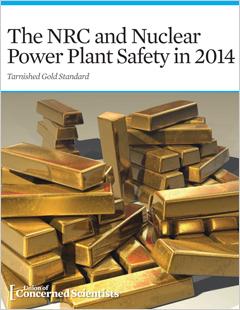Today UCS released its 5th annual report on the NRC and nuclear power safety. UCS started these reports in 2010 to examine each year examples of when the NRC acted to ensure nuclear safety as well as when it fell down on the job.
 These reports summarize incidents from the previous year when the NRC conducted “special inspections” to investigate an event or condition that increased the chance of reactor core damage by a factor of 10 or more. This year’s report also analyzes safety trends since 2010.
These reports summarize incidents from the previous year when the NRC conducted “special inspections” to investigate an event or condition that increased the chance of reactor core damage by a factor of 10 or more. This year’s report also analyzes safety trends since 2010.
The current report has both good news and bad news.
The Good News
The report finds that the number and severity of incidents leading to a special inspection have been steadily declining since our first review in 2010. There were 15 incidents in 2009 (reviewed in the 2010 report), 15 in 2011, 14 in 2012, 10 in 2013, and 9 last year (covered by the current report). The report finds the relative seriousness of these events also has decreased. Last year, the NRC also took steps to strengthen its reactor oversight process.
Dave Lochbaum, who authored the report, notes “The fact that the number of significant safety lapses is slowly dropping is encouraging. The longer this trend continues, the more likely it represents actual improvement and not luck.”
The Bad News
On the other hand, the report finds that the agency has been unnecessarily withholding non-sensitive safety data, tolerating inconsistent reporting methods from its field offices, and unfairly punishing whistleblowers who raised safety concerns.
For example, the NRC withheld virtually all documents it received from nuclear plant owners regarding fire protection and emergency planning since 2004. None of the documents could be construed as sensitive, and some of them involved plant owner requests for revisions to their operating licenses or exemptions from safety regulations. By approving these requests without releasing the relevant documents, the NRC deprived the public its legal right to review and contest the requests.
The report also notes that the NRC harassed two staff whistleblowers, Lawrence S. Criscione and Michael Peck, who have been the subject of multiple investigations by the NRC’s inspector general and relegated to dead-end jobs for raising safety concerns. Criscione blew the whistle on inadequate flood protection at the Oconee plant in South Carolina, while Peck—an inspector at the Diablo Canyon plant in California—objected to an NRC report that downplayed the seismic risks at his facility.
Going Forward
The report offers a number of recommendations. For example, it proposes that the NRC consider additional enforcement and inspection efforts to curb the adverse trend of electrical system failure and encourage plant owners to pay closer attention to safety when making modifications to their facilities and during maintenance procedures. It also states that the NRC should require plant owners to formally evaluate why their routine testing and inspection regimes fail to discover longstanding problems.
